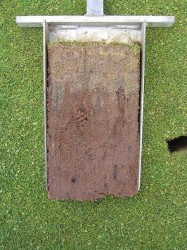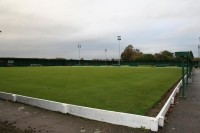January Bowls Diary
 As a new decade begins, it is perhaps a good time to reflect on what you have achieved in recent years, and then plan what you want to achieve in the coming years.
As a new decade begins, it is perhaps a good time to reflect on what you have achieved in recent years, and then plan what you want to achieve in the coming years.
Keeping records and monitoring the performance of your turf facility should be encouraged. How can we be expected to know how to improve the condition of the sward if we do not recognise or understand its current state?
Always keep records of the work you have carried out and the materials/products you have applied. Also, take the opportunity to take soil samples to monitor soil nutrient status and level of soil ph. When taking core samples you can also keep an eye on thatch content and soil moisture content.
To help you remember and record the facts use a digital camera.
January /February is a good time to take soil samples and get them sent off for analysis, thus enabling you to get them back in time to start your new year's maintenance
Ideally, if you have not had one done before you should have a full (PSD) Particle Size Distribution soil analysis done to tell you the actual make up of your soil profile.
Soil is made up of percentages of clay, silt and sand. The PSD Analysis will identify the ratio of these and confirm soil type, thus giving you a better understanding of what soil you are dealing with. Also, you can establish the amount of organic matter )OM) content as well as soil nutrient status and soil Ph. With this information you will be able to identify the needs of your soil.
The current weather, especially the recent cold spell, snow and ice, will have dictated what can be done. If you have had a lot of snow, keep an eye out for an outbreak of disease (snow mold). Snow can act as an incubator and induce the incidence of disease.
There are many jobs you can undertake during January. Firstly, it's important to ensure you are carrying out your daily brushing to keep the surface clean and, at the same time, removing any early morning dews. Keeping the playing surface clean and dry helps prevent disease and contamination. This can be achieved by using brushes and dragmats. Also, brushing of the green will help the sward stand upright allowing good air movement around the grass plant.
You should also be maintaining you winter height of cut at between 10-12mm. To help monitor the correct height of cut, use a prism gauge.
On your return after the holidays you are likely to find some accumulated surface debris (leaves, litter etc.) on the green and in the drainage ditches. It is important to clear it up.
Key Tasks
Cultural Practices
 January is a good time, whilst it is quiet, to plan and get yourself organised. What are your targets for this year? What do you want to achieve? Have you organised your spring renovation works? Have you ordered materials and machinery for the forthcoming season?
January is a good time, whilst it is quiet, to plan and get yourself organised. What are your targets for this year? What do you want to achieve? Have you organised your spring renovation works? Have you ordered materials and machinery for the forthcoming season?
Aeration: should be continued throughout the winter when conditions allow, the use of a sarrel roller will be beneficial in keeping the surface open.
Diseases: are fairly prominent this year. Keep an eye on fungal disease attack and use approved fungicides to treat infected areas. Good cultural practices generally reduce the likelihood of disease outbreaks.
Fertilising: generally, no fertiliser applications are made during the winter months, as plant growth has slowed down. However, some groundstaff may apply a dose of liquid iron to colour up and provide some strength to the grass plant.
Brushing/switching: keeps the green clean and removes any dew or surface water. Keeping the surface dry will aid resistance to disease.
Machinery and sundries: keep machines overhauled and clean. Arrange the servicing of your machines ready for the new season. Keep an eye on your material stocks, (seed, topdressing, petrol, oil ) remembering to replenish as required.
Perimeter fences and hedges: most bowling green facilities are enclosed by fences or hedges. January is a good time to complete any tidying up of these features. Hedges can be pruned and cut to maintain their shape and form.
Repairs: carry out any repairs to ditches, paths, gates, floodlights and other building features. Ideally, you should have your floodlights serviced on a annual basis to check that they are safe and operating to the correct LUX values. Also, check that the lights are correctly positioned, thus preventing unwanted light pollution.
For additional information see following link Sports Diaries
